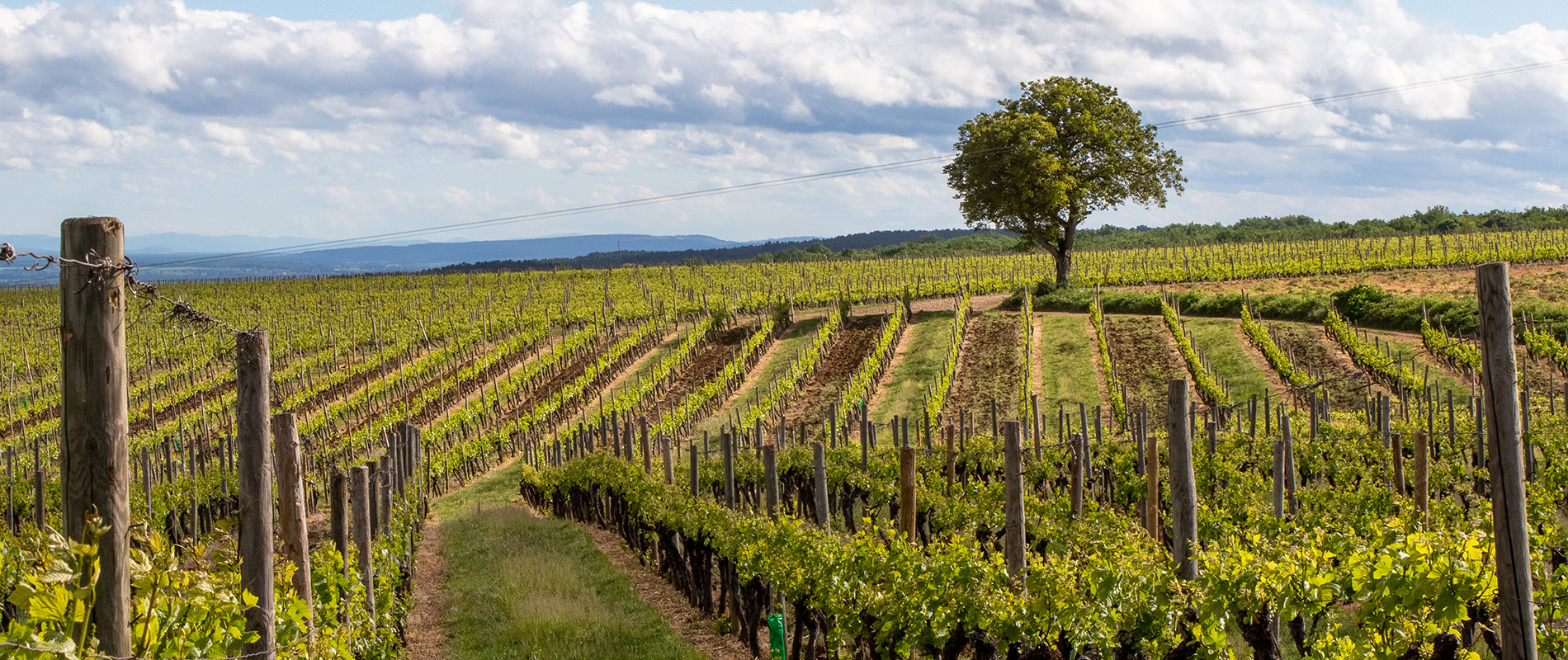
The vineyards
Committed to sustainable winegrowing
The virtuous circle
« To work in the vineyard is to carry out the same tasks as in times past but with modern tools. That is why we are constantly seeking to progress in the art of growing these precious plants. »
Frédéric Brand, oenologist

Feeding the grass with organic inputs, which in turn feeds the soil, which nourishes the vines.
Our approach, inspired by permaculture, is currently unique in Burgundy. The vineyard Les Nantelles (Northern Burgundy) is a perfect example.
Our basic ethical principle:
put people at the centre
Chenôvre, a preserved enclave of vines and nature, is a small estate near Beaune. The cool vineyard nestles on a hillside with an exceptional view of Mont Blanc on clear days. The vines are tended by vineyard workers from the ESAT (an organization that helps people with disabilities to find employment) in Beaune.
« This partnership allows them to practice a rewarding profession, which requires technical skills and enables individuals to develop professionally, despite the differences in abilities they may face. »

High vines
Rise up!
Our vines are high and wide. This enables better aeration and more leaves for healthy grapes. Easy rows for cultivation.
In the Hautes-Côtes our plots are located on the plateau, where stone is omnipresent. In Chaux, above Nuits-Saint-Georges, Aligoté and Pinot Noir grow on two slopes with different types of soil on hard crushed limestone.
In Villers-La Faye, more to the west, close to the parent rock, Pinot Noir offers its grapes in the middle of an area known for its fragrant raspberries.
In Bollery. La Vigne d'En Face, (“the vine opposite”) which is Clos Vougeot, a grand cru. Our high, wide, east-facing plot of vines grows in rich, deep soil.


Plant cover
Beautiful soil, beautiful vines
The vineyard soil lies on top of rock, and is covered with wild plants. There is an alchemy between flora, fauna and nourishing vegetation. The plant cover speaks to those who can read it, of life. Of vitality...
"Crimson clover and poppies bloom in our Molesme and Pothières vineyards; white is king here!”
David Guichard, Vineyard Manager for the Châtillonnais"For some years, grasses have been allowed to grow. We choose and sow species like red clover, a melliferous plant that nourishes and aerates the soil. And in the spring they are rolled and left lying on the soil. This grass cover creates a natural mulch that protects the soil from the heat and keeps it cool. And later, as it breaks down, it enriches the microbial life in the soil. This generates a biodiversity that is essential to the good health of our vines.

Flowers and wildlife
Flora and fauna reflect our vineyards’ mood and character
In the North. At Nantelles the wild geraniums reflect the soil’s fertility the soil and the orchids are part of the meadow’s character. The direct planting of our vines on grassland was a first in Burgundy! Organic by nature.
Paris l’Hôpital. In the south of Burgundy, the grey limestone contains numerous fossilized crustaceans from when it was covered by the sea. Since then, springs have been tapped, ditches dug, paths traced, peach trees planted, and seeds sown to retain the fine soil, the exquisite substrate for the Pinot Noir and Pinot Blanc.
In Molesme, the vines where poppies grow reflect a harsh climate with marked seasons. Here, full-scale trials are being conducted over several years on wide rows of plant cover, with red clover and vetch.
In Pothières, the youngest vines are covered with phacelia, a plant that is an excellent nectar source and serves as a green manure to decompact the soil.
When nature is respected, life abounds
In the south, in the hilly Couchois, the banks of the river Dheune offer a romantic setting for two young, south-west-facing plots of Pinot Noir. The soil is frequently ploughed and the vines are sowed with grasses, which thrive here.
Dracy-lès-Couches. The locality known as Vignes de Roche refers to the outcrops of the parent rock. On the hillside, the vines are planted on broad terraces. Between them, an impressive ditch collects rainwater. The Pinot Noir here benefits from good natural grass cover.
In the Maranges valley, our most bucolic vineyard flourishes, with its canal below, dry stone walls, wild fauna, surrounding woodland, and its young, vigorous vines!
Chenôvre. Nature exalted. A haven of peace, where the animals of the fields and the forest mingle: birds, wild boar, deer, and hares. And, on a clear day, Mont-Blanc in the distance!
